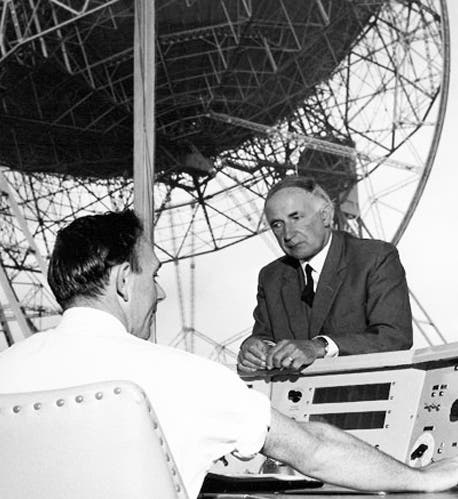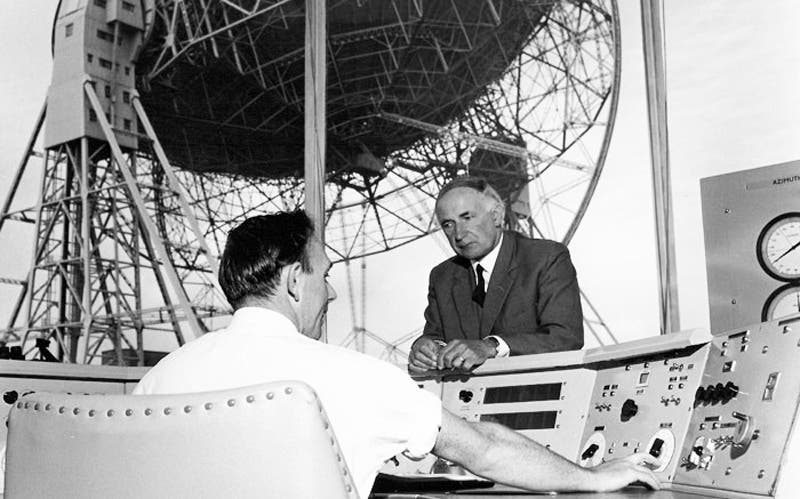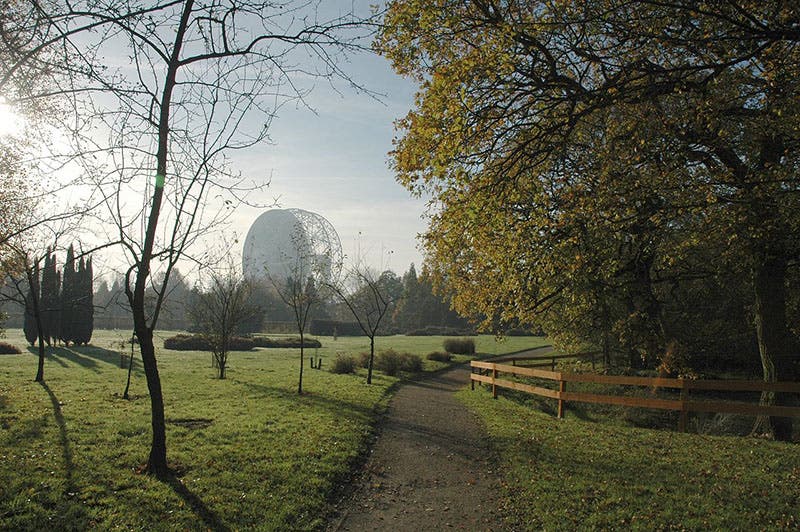Scientist of the Day - Bernard Lovell
Bernard Lovell, an English astronomer, was born Aug. 31, 1913. Lovell trained as a physicist in Bristol, and he worked on radar projects during World War II, so it is not too surprising that, after the war, he gravitated toward the relatively new field of radio astronomy. He was interested at first in using radar to study meteor showers, and he was able to lay his hands on some war-surplus radar equipment, as well as searchlights on which he could mount small radio-wave receivers.
Lovell worked at the University of Manchester, but it was too noisy there, radio-wise, so he looked for a more remote location to set up his equipment, and settled on some land owned by the department of botany about 25 miles south. The area was called Jodrell Bank, and by December of 1945, Lovell had installed his first receivers and was tracking meteors, just in time for the Geminid meteor shower. A photo shows us what the initial set-up looked like at Jodrell Bank (second image).
Since radio waves are much longer than the microwaves used by radar, Lovell needed larger antennas, and he built several. By far the most famous is the one that was put into operation in 1957. It was 250 feet across and fully maneuverable, the largest such radio telescope in the world at that time, and is still, 65 years later, the third largest. It was used to track Sputnik when it went up that same year, and quite a few spacecraft of the 1960s – in many cases, it was the only telescope in the world that could receive signals from certain spacecraft. It was also used to track Soviet satellites during the Cold War. Primarily, however, it looked for radio waves from other solar system objects, and from space beyond. In 1987, the 250-foot telescope was renamed the Lovell Telescope in Lovell’s honor. There are many radio telescopes now at Jodrell bank, but there is no doubt that the Lovell telescope is the one everyone pictures when they hear the name “Jodrell Bank.”
In 2006, the BBC held a contest, as the BBC often does (see our post on Beaker the Muppet), asking viewers, listeners, and readers to vote for their favorite "unsung national landmark," and the Lovell Telescope won, beating out the Humber Bridge and the New Severn bridge in the process. You can see the poll results here. It doesn't seem to have bothered anyone that the phrase "most popular unsung national landmark" is oxymoronic. Be that as it may, the Lovell Telescope is clearly a favorite with Brits, and I hope that Sir Bernard, who was still very much alive in 2006, was pleased with the popularity of his behemoth, and perhaps even cast a vote in its favor. Sir Bernard died at the age of 98, on Aug. 6, 2012, the very day that the Mars Curiosity rover landed on the surface of Mars. I do not know if it was tracked by the Lovell Telescope, but I would like to think so.
Jodell Bank was named a World Heritage Site by UNESCO in 2019. There is a lovely photo of the Lovell Telescope on the UNESCO website, which we show as our final image.
William B. Ashworth, Jr., Consultant for the History of Science, Linda Hall Library and Associate Professor emeritus, Department of History, University of Missouri-Kansas City. Comments or corrections are welcome; please direct to ashworthw@umkc.edu.










